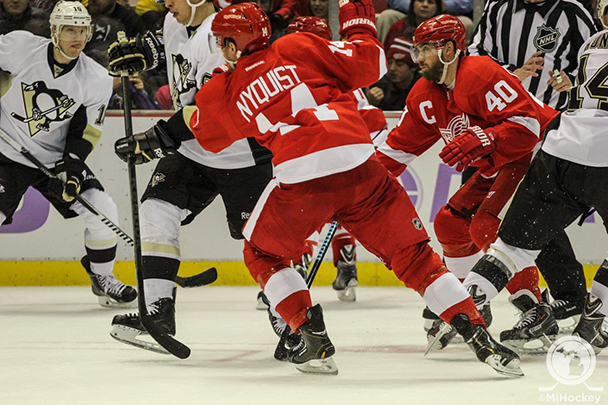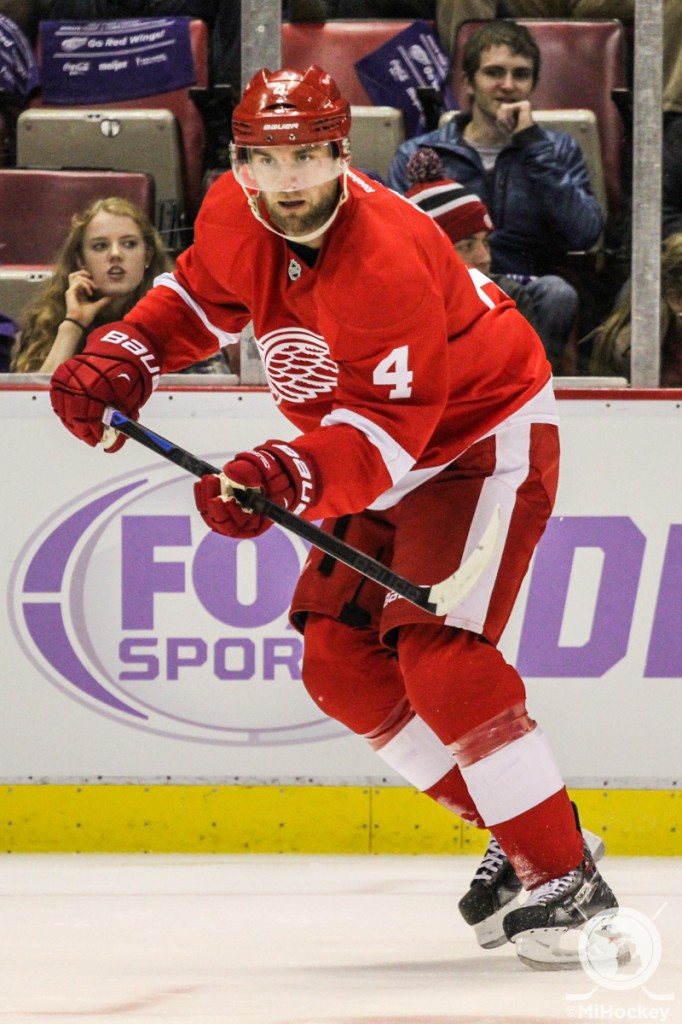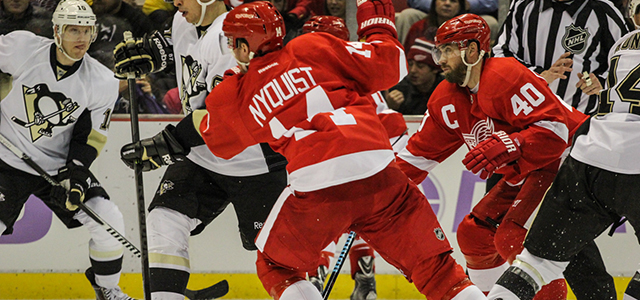Power-play woes damper Red Wings’ start to 2014-15

By Dave Waddell –
As the first month of the season nears an end, the Detroit Red Wings (4-2-2) aren’t what we thought they’d be.
The question marks were supposed to swirl around their defense and whether goalie Jimmy Howard would return to all-star form.
The given was supposed to be the Wings’ group of forwards, a solid mix of veterans and youngsters who began to blossom last year.
As it turns out, the questions now are all about what’s wrong with the Wings’ offense and how their power play is converting at just over a 6 percent rate. Following a 4-2 loss in Philadelphia, the Wings had scored two power-play goals in 30 chances and had been shutout in each of the last five games when enjoying the extra skater.
“We’ve got to attack the net,” coach Mike Babcock told Detroit reporters after seeing his team run their streak of power-play failures to 20 consecutive chances. In order to attack the net you’ve got to trust you’ll get it back. You’ve got to trust you’ll win face-offs, so we just got to start attacking the net.
“We’re going to go through all the details of the power play. We talked about it. We’re going to get a fresh start.
“We got 74 games left, so let’s make sure it’s at the top of the league.”
The Wings can’t afford to be overly patient.
Babcock promises to tinker with the power-play unit, but he’s not ready to give up on the diamond-shaped system the Wings have been using.
It has a single shooter at the top of the diamond who can rotate out. It allows for the Wings to outnumber teams down low and along the half-wall and does encourage more free-flowing movement.
Where’s it failed is the Wings have been too happy to play on the perimeter. They’ve moved the puck around nicely at times, but the Wings rank 27th in the NHL in shots per power play with a sickly average of 1.17 shots.
Detroit has also frequently used center Pavel Datysuk at right point. Though he’s got freedom to roam, starting up high has frequently left him too far away from the danger spots down low where he works his best magic.
Babcock is convinced it’s not the formation that’s the problem, just the execution and finding the right mix of personnel.
Datsyuk, Zetterberg, Niklas Kronwall, Tomas Jurco and Darren Helm have been Detroit’s first power-play unit. The second group includes Riley Sheahan, Andrej Nestrasil, Gustav Nyquist, Tomas Tatar and Danny DeKeyser.
Each group contains only one defenseman.
Babcock said he has no plans to go back to the traditional two defensemen at the points, especially since the Wings don’t have a right-handed blue-liner to pair with a lefty. It’s a decision that Henrik Zetterberg supports.
“If you look around the league, there’s not a lot of teams that don’t have that system,” Henrik Zetterberg told Detroit reporters. “It’s proven that it’s working.
“We’re too careful. We’re afraid of losing the puck, so we’re not shooting. We have to shoot and (when) the goalie makes the save we have to retrieve the pucks.”
The Wings struggles on the power play are highlighted even more by the fact the team is struggling to score overall.
Detroit has only scored more than two goals twice in the first eight games. The Wings are averaging 2.25 goals per game ranking them 25th in the NHL.
Certainly getting the injured Johan Franzen back will help both on the power play with his net-front presence, and in five-on-five play. Franzen is getting closer to returning from a sore groin, but there is no firm timetable for his return nor has he begun to practice yet.
 Defense showing signs of growth
Defense showing signs of growth
The good news for the Wings is they’ve been much better than anticipated defensively and Howard is once again looking like himself between the pipes. Detroit is tied for seventh in the NHL with a 2.00 goals-against average.
Jakub Kindl, who has improved his play significantly over last season, leads the team’s defensemen with a plus-three rating.
Most encouragingly, the Wings’ middle pairing of DeKeyser and Brendan Smith are both even or plus players.
“DeKeyser is better and Smith is better, “Babcock said. “That’s how you get to be better is you get growth from within.
“If they can keep getting better, we’re going to be better.”
Though he still shows tinges of the impatience of youth, Smith is demonstrating he’s learning to play a simpler game.
The young defenseman admits there’s no escaping that an NHL education means no one escapes learning from their rash mistakes.
“It’s trial and error for a lot of things, because you haven’t seen things,” Smith said.
“I’ve been playing my whole life, but you don’t see a guy like Sidney Crosby take you wide with that kind of speed and his kind of skill until you get to the NHL.
“What I’m happy with is that I’ve continued to get better every game, every year. That’s something I want to keep continuing to do.”

